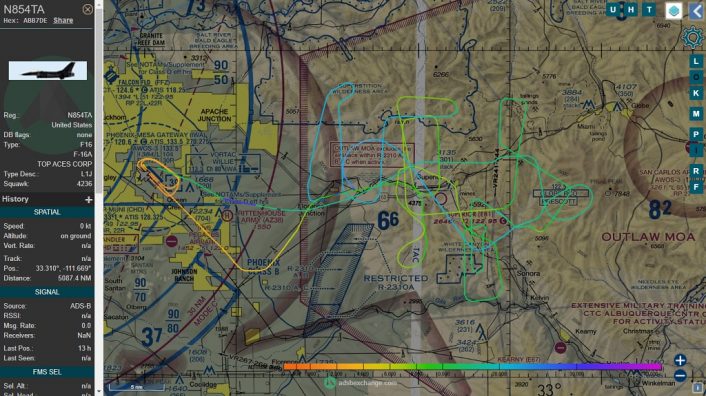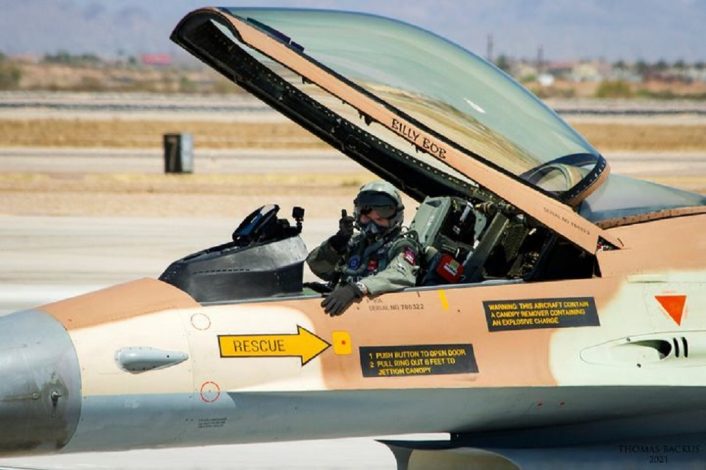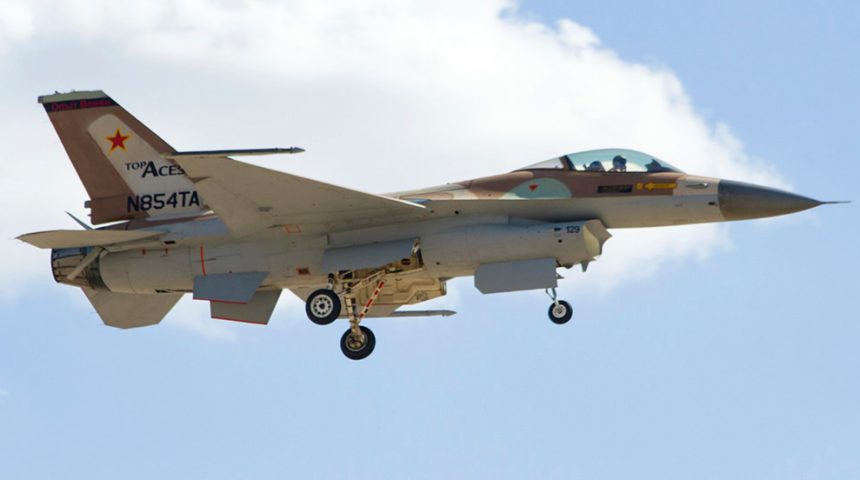The former Israeli F-16 flew from the Top Aces’s facilities at Phoenix Mesa Gateway airport and is the first 4th generation fighter flown by private “Red Air”.
The Canadian company Top Aces performed on May 18, 2021 the first flight of one of its former Israeli F-16As since their arrival in the United States earlier this year. The aircraft, which was trackable online through ADS-B, is the former Israeli Netz 129 (USAF serial 78-0322), also known for its involvement in Operation Opera in 1981. Before yesterday’s flight, the F-16 received its new civilian registration N854TA.
Based on its ADS-B track, the F-16 flew from Phoenix Mesa Gateway airport (Arizona) for just over an hour, testing its entire flight envelope in the nearby Outlaw Military Operations Area, a big reserved chunk of airspace East of Phoenix which is used also by F-16s and F-35s from Luke Air Force Base. As standard for Functional Check Flights, the aircraft maneuvered at various altitudes, from 8,000 ft to 23,000 ft, and speeds, including high-speed runs at 600 kts, slow flight at 80 kts and stall testing.
As we can see in the photos kindly provided to us by aviation photographer Thomas Backus, the F-16 kept its original Israeli Air Force desert camouflage with the addition of its new registration on the vertical fin-root fairing, while on the vertical fin itself we can see the Top Aces logo and the classic red star usually seen on Aggressor aircraft. On top we can also see a black stripe with a red marking written in Cyrillic, “Опыт Важен”, which should mean “Experience Is Important”. As noted at the time of the delivery, the markings from Operation Opera were removed when the aircraft was prepared in Israel.
Top Aces signed in 2020 a deal with the Israeli Ministry of Defense for the unprecedented sale of 29 F-16 Netz (Hawk), as they are locally known, which were retired from the Israeli Air Force at the end of 2016. The first four aircraft were disassembled and flown inside a Ukrainian Antonov An-124 to Phoenix-Mesa Gateway airport, home of the newly established Top Aces F-16 Center of Excellence. Thanks to this deal, Top Aces is now the first company to offer 4th generation fighters to provide “Red Air” aircraft for the training of US military pilots.

As we reported in the past, the U.S. Air Force is contracting the adversary training under the Combat Air Forces (CAF)/Contracted Air Support (CAS) program to improve the training of the Formal Training Units (FTU) and increase the number of new pilots trained. The original CAF/CAS contract was announced to cover 40,000 flight hours of adversary training at 12 different air bases and 10,000 flight hours is support of Joint Terminal Attack Controllers (JTAC) training at nine Army bases, later reduced to a little less than 9,000 flight sorties at six bases for the first year and an optional three year-extension for a total of over 26,000 flight sorties.
The six bases involved are Kingsley Field ANGB, Luke AFB, Holloman AFB, Eglin AFB, Seymour Johnson AFB and Kelly Field, home of FTUs for F-15s, F-16s, F-22s and F-35s. The Air Force is wishing to provide the same adversary support to all air bases, but due to the budget it was decided to prioritize training bases. ATAC, Draken and Tactical Air have already been awarded contract for these bases. Top Aces was not among the initial round of contract awardees, however the company mentioned that they will begin providing adversary training for the USAF, U.S. Navy and DoD in 2021 under the 2019 indefinite delivery, indefinite quantity contract.
The Israeli F-16s delivered to Top Aces have been upgraded through the years, reportedly receiving similar capabilities to the F-16C and also a new cockpit with three Multi-Function Displays (MFD), Helmet Mounted Display (HMD) and an upgraded Head-Up Display (HUD), in addition to Israeli avionics and Electronic Warfare (EW) suites. It is not known if any of these features have been removed before the sale, however Top Aces’ press release at the time of the delivery mentioned that “the upgraded fleet of F-16s are able to employ an Active Electronically Scanned Array (AESA) radar, helmet-mounted cueing system, tactical datalink and high off boresight missile capability to provide unparalleled adversary air training”.

These capabilities, together with the performance of the F-16, will surely be much valued while simulating higher end 4th and 5th generation threats that US pilots may have to face in the future. Other private adversary aircraft currently available, like the Mirage F1, F-5 Tiger, A-4 Skyhawk and Hawker Hunter, while deeply upgraded in some cases, are still somewhat limited by their older airframes and systems which can in turn limit the choice of the new systems to be installed to simulate newer capabilities in a combat scenario.
The Top Aces F-16s might be joined soon by its former adversary in the Lightweight Fighter program, the F/A-18 Hornet. In fact, as reported by our friends at The Warzone, Air USA is about to receive the Legacy Hornets that the Royal Australian Air Force is dismissing this year as they are replaced by the F-35A Lightning II. As the ex-Israeli, these F/A-18s have been deeply upgraded through the years and it is reported that they will be delivered in the same configuration flown by the RAAF, with no equipment being removed.
Thanks again to Thomas Backus for the photos he sent us and make sure to follow him for more!









